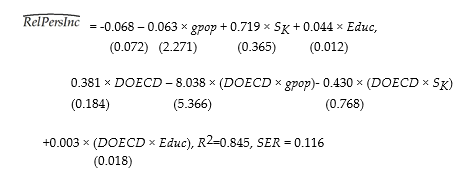An extension of the Solow growth model that includes human capital in addition to physical capital, suggests that investment in human capital (education) will increase the wealth of a nation (per capita income). To test this hypothesis, you collect data for 104 countries and perform the following regression: 
where RelPersInc is GDP per worker relative to the United States, gpop is the average population growth rate, 1980 to 1990, sK is the average investment share of GDP from 1960 to 1990, and Educ is the average educational attainment in years for 1985. Numbers in parentheses are for heteroskedasticity-robust standard errors.
(a) Interpret the results and indicate whether or not the coefficients are significantly different from zero. Do the coefficients have the expected sign?
(b) To test for equality of the coefficients between the OECD and other countries, you introduce a binary variable (DOECD), which takes on the value of one for the OECD countries and is zero otherwise. To conduct the test for equality of the coefficients, you estimate the following regression:
Write down the two regression functions, one for the OECD countries, the other for the non-OECD countries. The F- statistic that all coefficients involving DOECD are zero, is 6.76. Find the corresponding critical value from the F table and decide whether or not the coefficients are equal across the two sets of countries.
(c) Given your answer in the previous question, you want to investigate further. You first force the same slopes across all countries, but allow the intercept to differ. That is, you reestimate the above regression 
The t-statistic for DOECD is 4.39. Is the coefficient, which was 0.241, statistically significant?
(d) Your final regression allows the slopes to differ in addition to the intercept. The F-statistic for 
What is your decision? Each one of the t-statistics is also smaller than the critical value from the standard normal table. Which test should you use?
(e) Looking at the tests in the two previous questions, what is your conclusion?
Correct Answer:
Verified
View Answer
Unlock this answer now
Get Access to more Verified Answers free of charge
Q28: Earnings functions attempt to find the determinants
Q29: Consider the following least squares specification between
Q30: You have been asked by your younger
Q31: Pages 283-284 in your textbook contain an
Q32: In the log-log model,the slope coefficient indicates
A)the
Q34: Consider the population regression of log earnings
Q35: Labor economists have extensively researched the determinants
Q36: Assume that you had estimated the following
Q37: Consider the polynomial regression model of degree
Q38: In the regression model Yi = β0
Unlock this Answer For Free Now!
View this answer and more for free by performing one of the following actions

Scan the QR code to install the App and get 2 free unlocks

Unlock quizzes for free by uploading documents